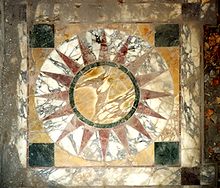Opus sectile



Opus sectile ( Latin for "cut work") describes an artistic technique popular in ancient Rome , in which various materials were cut into pieces and placed in walls or floors in order to form an image or pattern. The starting material - marble , mother-of-pearl or glass - was cut into thin slabs, polished and cut again according to the design project. In contrast to the mosaic , which consists of a large number of uniformly large pieces, the pieces in the opus sectile are much larger and can already represent large parts of the design.
origin
Although early examples were found in Egypt and Asia Minor , the most prominent artifacts come from 4th century Rome . A large specimen from the basilica of the Roman consul Iunius Bassus , depicting a chariot , has been preserved . Opus sectile's popularity continued in Rome into the 6th century , eventually reaching Constantinople (today's Istanbul in Turkey ).
Examples
One of the most important works in opus sectile technique is the gold glass table by Caesarea Maritima , which was found during excavations in a pompous villa on the outskirts of Caesarea Maritima in 2005 and dates from the late Roman period. The frame of the mosaic is made up of gold glass tiles and tiles made of turquoise, opaque glass, the central field is made up of squares, triangles and narrow rectangles made of glass, which join together to form a geometric pattern. The square gold glass plates have relief decorations and represent crosses and rosettes.
Newer use
While the opus sectile technique eventually disappeared in Rome, it continued to be used in the Byzantine churches, mainly in the floors. It was also cultivated by the Greeks who may have brought it to Italy and Sicily in the 12th century .
See also
literature
- Liz James: Opus sectile . Grove Art Online, Oxford University Press.
Web links
- Opus sectile. Antike-Tischkultur.de
- Pompeii, Opus sectile. Kantonsschule Zürcher Unterland (former website)
- Opus sectile mosaic. The Joy of Shards mosaics resource.